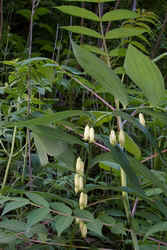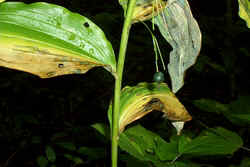 |
 |
|
 |
Common Name: Solomon's Seal
Genus: Polygonatum biflorum
Family: Liliaceae
North Carolina Native Wildflower
Pierson Falls Road
Polk County, North Carolina
Flower -- May 6, 2002
Berry -- August 25, 2002
 |
 |
|
 |
The long, arching stems of this native perennial may reach 2 - 3 feet in length. It is easily distinguished from the False Solomon's Seal by the larger flowers, 1/2 - 3/4 inch long, and later the black fruits, borne in small clusters along the stem rather than in a terminal inflorescence. Plants of this widespread species of eastern North America are found scattered in deciduous woods and clearings generally throughout North Carolina. The fruits occur in early fall. April - May [Justice, William S. and Bell, C. Ritchie, Wild Flowers of North Carolina. University of North Carolina Press, Chapel Hill, 1968]
This is a low-growing plant common to rocky woods, thickets, and forest edges. The arching stem is 1 to 3 feet long with a number of evenly spaced, alternate, ovate, and untoothed leaves. The 1/2-inch-long, greenish white flowers hang like tiny bells from the leaf axils. By early August, the blossoms are transformed into round, bluish blackberries. The generic name Polygonatum is derived from the Greek words poly and gonum meaning "many jointed" and referring to the number of joints in the rootstock. The species name biflorum refers to the flowers, which hang in pairs. The most widely accepted origin for the common name comes from the fact that the rootstock has scars that are shaped somewhat like a signet used as a royal seal. The plant's namesake, of course, is King Solomon, the tenth-century B.C. king of Israel who was famed for his wisdom and who, it was thought, possessed great knowledge concerning medicinal herbs. It was believed that he placed his seal of approval on this plant, that is, the Solomon's seal. Indians and early mountain settlers boiled and ate the starchy roots like potatoes and also ground the dried roots into flour. The leaves were crushed and used as a poultice to soothe scrapes and bruises. April - June [Alderman, J. Anthony, Wildflowers of the Blue Ridge Parkway. The University of North Carolina Press, Chapel Hill, 1997]
The root scars are an indicator of the plant's age -- each year produces a new circle. Some plants have been determined to be at least 50 years old. April - June [Adams, Kevin and Casstevens, Marty, Wildflowers of the Southern Appalachians: How to Photograph and Identify Them. John F. Blair, Publisher, Winston-Salem, 1996]
January February March April May June July August September October November December
Alphabetical Listings -- A B C D, E F G H I, J, K L M N, O P Q, R S T U, V W X, Y, Z
Family Listings -- A B C D, E F G H I, J, K L M N, O P Q, R S T U, V W X, Y, Z
Genus Listings -- A B C D, E F G H I, J, K L M N, O P Q, R S T U, V W X, Y, Z